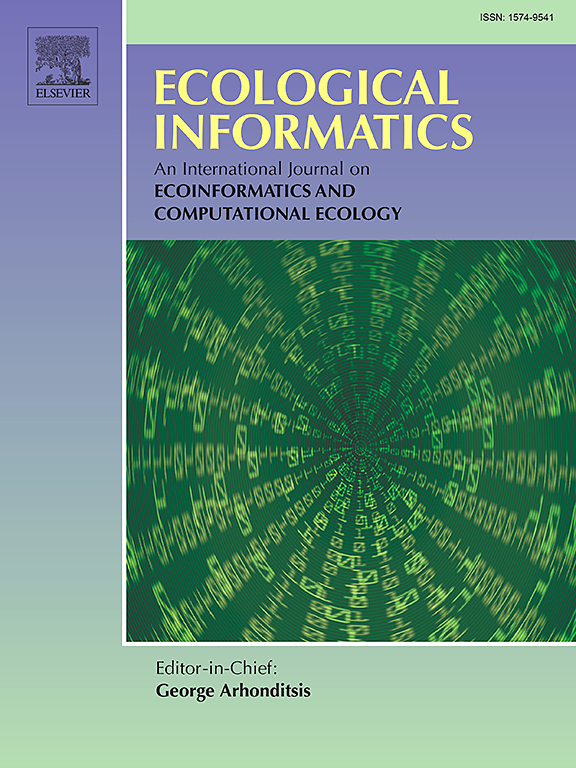非洲疟疾媒介生态位重叠的时空动态
IF 5.8
2区 环境科学与生态学
Q1 ECOLOGY
引用次数: 0
摘要
疟疾仍然是撒哈拉以南非洲的一项重大公共卫生挑战,感染寄生虫疟原虫的初级和次级蚊子的动态加剧了传播。两种病媒类型共存的地区面临疟疾传播加剧的更大可能性。因此,了解媒介的生态相互作用,特别是它们在地理或环境空间中的生态位重叠,对于有针对性的疟疾控制和消除战略至关重要。我们采用动态元胞自动机(CA)模型来绘制冈比亚按蚊(Anopheles gambiae)复合体、冈比亚按蚊(Anopheles gambiae)和冈比亚按蚊(Anopheles gambiae)的生态位重叠。(1)和(2);pharoensis,。使用开放获取的地理空间门户网站提供的开放获取环境和病媒发生数据集,时间跨度为1985年至2021年。在建模之前,我们进行了探索性数据分析(EDA),包括描述性统计、相关分析和聚类分析,以了解变量之间的关系。Spearman相关分析显示弱显著相关(|r| <;0.3, p值<;0.001),而环境变量表现出很强的相互关系。此外,一个。冈比亚菌复合体在相对湿度最低为22%的高海拔地区流行,而次生媒介在湿度38%、温度高于20°C的低海拔地区流行。我们的模型在验证后的准确性超过0.9,揭示了非洲各地疟疾媒介生态位重叠的扩大,这是由于媒介扩展到其原生区域之外。这种不断扩大的病媒生态位重叠,使许多地区容易面临持续和长期疟疾传播的风险,强调需要有针对性的疟疾病媒控制干预措施。此外,结合持续数据更新的动态建模方法准确地捕捉了生态相互作用。本文章由计算机程序翻译,如有差异,请以英文原文为准。

Spatio-temporal dynamics of malaria vector niche overlaps in Africa
Malaria remains a significant public health challenge in sub-Saharan Africa, with transmission heightened by the dynamics of primary and secondary mosquitoes infected with Plasmodium parasites. Regions where both vector types co-exist face heightened likelihood of intensified malaria transmission. Hence, understanding vectors' ecological interactions, especially their niche overlaps in geographic or environmental space, is crucial for targeted malaria control and elimination strategies. We employed a dynamic cellular automata (CA) model to map niche overlaps among primary (Anopheles gambiae complex, An. funestus group) and secondary (An. pharoensis, An. coustani) malaria vectors across African, using open-access environmental and vector occurrence datasets sourced from open-access geospatial portals, and spanning 1985 to 2021. Prior to modeling, we conducted exploratory data analysis (EDA) involving descriptive statistics, correlation and cluster analysis to glean insights into the relationships between the variables. Spearman correlation analysis revealed weak significant correlations (|r| < 0.3, p-value <0.001) between environmental variables and vectors occurrence, while environmental variables exhibited strong intercorrelations. Furthermore, An. gambiae complex prevailed at higher elevations with a minimum relative humidity of 22 %, while secondary vectors prevailed at lower elevations with humidity >38 % and temperatures above 20 °C. Our model, with accuracy exceeding 0.9 following validation, revealed expanding malaria vector niche overlaps across Africa, attributed to vectors expansion beyond their native regions. Such expanding vector niche overlaps predisposes numerous areas at risk of sustained and prolonged malaria transmission, underscoring the need for targeted malaria vector control interventions. Furthermore, dynamic modeling approaches, incorporating continuous data updates, captured ecological interactions accurately.
求助全文
通过发布文献求助,成功后即可免费获取论文全文。
去求助
来源期刊

Ecological Informatics
环境科学-生态学
CiteScore
8.30
自引率
11.80%
发文量
346
审稿时长
46 days
期刊介绍:
The journal Ecological Informatics is devoted to the publication of high quality, peer-reviewed articles on all aspects of computational ecology, data science and biogeography. The scope of the journal takes into account the data-intensive nature of ecology, the growing capacity of information technology to access, harness and leverage complex data as well as the critical need for informing sustainable management in view of global environmental and climate change.
The nature of the journal is interdisciplinary at the crossover between ecology and informatics. It focuses on novel concepts and techniques for image- and genome-based monitoring and interpretation, sensor- and multimedia-based data acquisition, internet-based data archiving and sharing, data assimilation, modelling and prediction of ecological data.
 求助内容:
求助内容: 应助结果提醒方式:
应助结果提醒方式:


